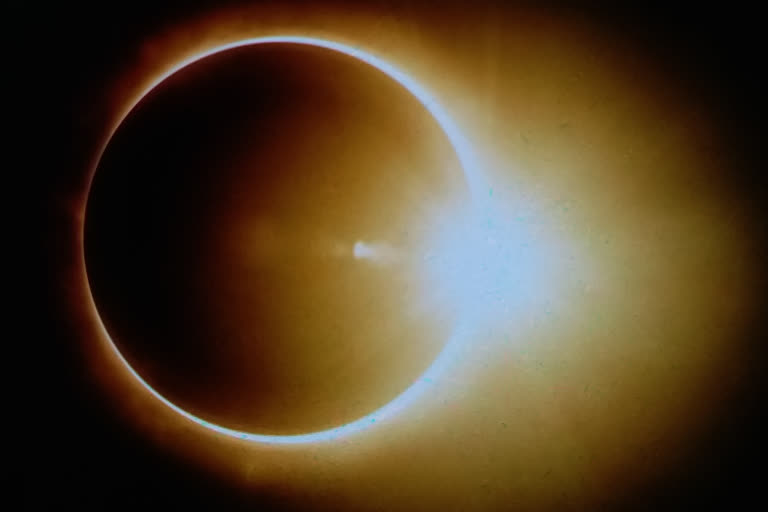New Delhi: An annular Solar eclipse will be observed on Sunday from the northern parts of India starting at 10:25 am. In this context, Aryabhatta Research Institute of Observational Science's under Department of Science and Technology, Government of India, will live telecast the Solar eclipse via YouTube, Facebook and zoom.
The solar eclipse is a process when the moon comes in between the earth and the sun. Because the moon is now obstructing the light of the sun, it casts a shadow on the earth. Solar Eclipse of much talked about the year 2020 will occur on Sunday, June 21. This will be a ring of fire, where the moon will cover the sun in a manner that it forms a ring.
The annular solar eclipse occurs when the Sun, Moon and the Earth are aligned in a straight line and almost on the same plane. The 'ring of fire' can best be seen, just for a minute, from Suratgarh and Anupgarh in Rajasthan, Sirsa, Ratia and Kurukshetra in Haryana, and Dehradun, Chamba, Chamoli and Joshimath in Uttarakhand.
This Solar eclipse will be observed from some parts of Africa, Asia and some parts of Europe. Interestingly the peak eclipse will be observed in the Northern part of India which will start at 10:25 am with maximum eclipse at 12:08 pm and ending at 1:54 pm.
Another annular eclipse was observed on December 26, 2019, from Southern parts of India and as a partial eclipse from different parts of the country.
The next annular solar eclipse is expected to be visible from India in the next decade occurring on May 21, 2031, while a total solar eclipse will be seen on March 20, 2024.
"Astronomical events such as eclipse are exceptional opportunities to excite and instruct the youth and indeed the society at large about science and to instil scientific temper," said Professor Ashutosh Sharma secretary department of Science and Technology Government of India.
Why Solar eclipse occur?
A solar eclipse occurs when the moon(at new moon phase) blocks the solar disc partially or completely leading to a partial, annular or total solar eclipse. During the eclipse, the shadow of the Moon falls on Earth and constitutes a darker region known as umbra and the relatively less dark region called the penumbra.
The total solar eclipse is the rarest of the solar eclipse. Even though there is a New Moon every month, eclipses are not witnessed so often. This is due to the fact that orbit of the moon is inclined at an angle of around 5 degree with respect to Earth-Sun plain.
This leads to alignment of the Sun, Moon and Earth as rare astronomical phenomena.
Do's for the solar eclipse
1) Use eclipse glasses ( ISO Certified) or camera with proper filters attached to watch the eclipse and avoid any damage to the eyes.
2) Projection on screen using a pinhole camera for tally course scope is the safest way to watch, and annular solar eclipse.
3) It is ok to eat, drink, take bath and go out during eclipse.
Don'ts for the solar eclipse
1) Do not observe the sun directly by the naked eye.
2) Do not use x-ray films on normal sunglasses even with UV production to view the eclipse.
3) Do not use painted glass to see the eclipse.
ALSO READ: WATCH: Trucks carrying fertilisers looted in Madhya Pradesh's Shajapur



